When deciding on a pricing model, there are many aspects to consider. It all starts with business targets, market analysis, and picking up a pricing strategy. Different capabilities are then needed to be able to execute the selected strategy. For agile strategies, agile tools are needed.
Choosing Pricing Strategy
There are four basic viewpoints for setting a pricing strategy: cost, competition, market maturity, and value. Here are five strategies based on these viewpoints.
1. Cost plus margin pricing strategy
Basing your pricing strategy on your costs can be a quick and easy way to guarantee a profit, as long as you meet sales goals. Essentially, take your cost level and add a suitable markup. This is an easy-to-understand and easy-to-apply model. But, as noted below, it is often not well-aligned with market dynamics and customer value.
Pros:
|
Cons:
|
2. Competitive pricing strategy
When using a competitive pricing strategy, you first look at the competition and align the prices with them a bit. To do this, you need to analyze your competitors' prices across all customer categories, from individual users and small businesses to large enterprises.
You should also take a look at the features and benefits of their offerings, as well as any discounts or promotions they may be offering customers. By conducting an in-depth analysis of your competitors and their offerings, you can ensure that your services are properly priced to remain competitive while continuously providing value.
But looking too much at what the others are doing may be too easy and not optimal. Too aggressive pricing will hurt margins. Value is not honored much there and you may also leave money on the table in the end.
Pros:
|
Cons:
|
3. Price skimming
Price skimming means setting prices as high as possible in the beginning and adjusting lower if needed. This maximizes margins per unit. This strategy, however, is quite distinctive and does not suit every business. With innovations, price skimming might work, with prices starting high and lowering over time. For those with an effective brand image price skimming may be a long-term strategy. But, of course, your brand should be so strong that it has a positive effect on customer value.
Pros:
|
Cons:
|
4. Penetration pricing
When looking at a quick market share increase, penetration pricing may be worth considering. To do it, you enter the market with a tempting price and increase as market share improves. Be careful not to sacrifice your margins in the long run.
Pros:
|
Cons:
|
5. Value pricing strategy
It is often said that the most important aspect of a price is customer value so maybe consider building your pricing strategy based on that!
A good value pricing strategy demands a thorough understanding of customers since value perception varies between customer segments as much as between individual customers. But knowing your customers is increasingly a must for any business nowadays. The importance of data grows, and the best performers can benefit from that data.
Pros:
|
Cons:
|
Pricing model types
After initially setting the pricing strategy, you need to consider the actual pricing models. For recurring services, there are several typical pricing models available, such as pay-as-you-go, subscription plans, and usage-based fees. It is important to weigh your options when determining which pricing model works best for your company and selected strategy. The most typical pricing models are Flat fee, Unit, Tier, Volume, and Overage but there are also variations of those.
| Flat-rate pricing models | |
| Fixed one-time | Customers pay a sum once. |
| Fixed recurring | Customers pay a sum for each period of service. |
| Consumption-based pricing models | |
| Unit | Customers pay a certain sum for each unit consumed. |
| Tier | Customers pay a different price point based on certain tiers or levels of usage, features, or quantity. Typically, the more a customer purchases or uses, the lower the unit price becomes. |
| Volume | Customers pay for a product or service based on the quantity purchased. The more a customer buys, the lower the unit price becomes. |
| Overage | Customers pay an additional fee for exceeding a certain pre-determined limit or threshold of usage. |
There is an overall trend towards consumption-based models as they typically are better aligned with value: customer pays according to usage and also have more control than with flat fee pricing. Evaluating your capabilities on pricing and billing is very important there. A mismatch between the pricing models and capabilities creates lots of manual work and may lead to revenue leakage and eventually customer churn.
With low pricing capabilities, it may be wise to stick with simpler, flat-fee pricing. If that is against your pricing strategy, you should consider looking to improve capabilities: processes, and especially systems on pricing and billing. This also applies to companies that are transforming from products to services: evaluate capabilities first and only after that go for this change. Otherwise, the transformation may not succeed, not because of a lack of motivation but a lack of capabilities: processes and systems.
Putting Customers First
Finally, perhaps the most important factor when selecting a pricing model is understanding your customer's needs and preferences. This means finding out what features they need and value, as well as how much they are willing to pay for them. It is important to remember that not all customers perceive value in identical ways. Processes and systems are the key there as you need data and insight into customer behavior and combine that data across the organization, from product to sales and customer service. Again, a capable subscription management system helps there as it automatically gathers much of the needed data.
Testing
Experimenting with pricing models is valuable for B2B businesses, as it helps them to better understand customer needs and tailor their offerings accordingly. By trying out different pricing structures, they can gain insights into which services are most profitable and popular with customers, allowing them to make improvements in areas where demand is low or cheaper alternatives may be desired.
However, your ability to experiment with pricing models will depend entirely on the agility of your pricing solution. Automating pricing and billing processes can make it simpler for businesses to experiment with different models. This eliminates the need for manual effort and reduces time and cost associated with adjustments, freeing up resources to focus on other areas such as customer service and product development.
Agility is the Key to Strategy
There is no one-size-fits-all solution to pricing strategies, pricing model types, or customer preferences. Only with continuous experimentation can a B2B SaaS company find the right combination of strategies to maximize profits. The architecture of your billing solution must support the influx of data and enable instantaneous changes to all aspects of pricing strategy.
Read more on Recurring revenue business models
If you are ready to find the ideal enterprise pricing model for your business, or if you are just curious to learn how Good Sign does things differently, feel free to take us to the test! We will gladly take on your challenge and prove to you it can be done, and that the new world lies beyond just subscriptions.





